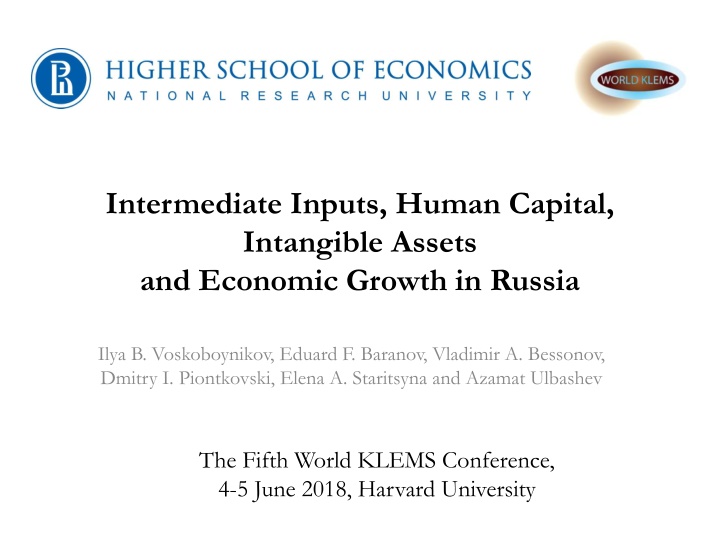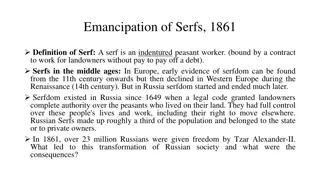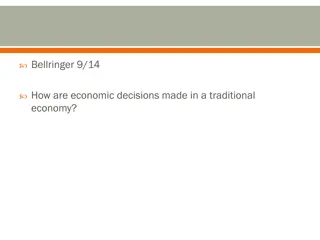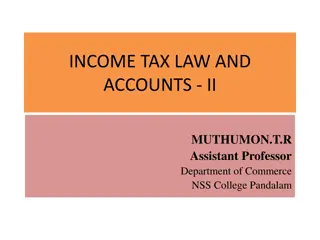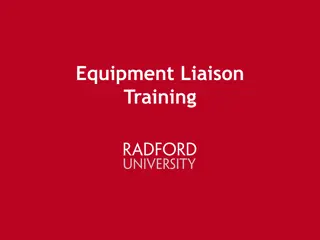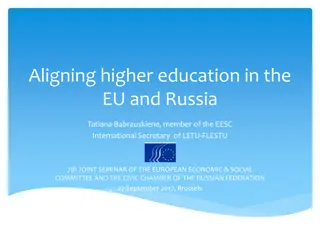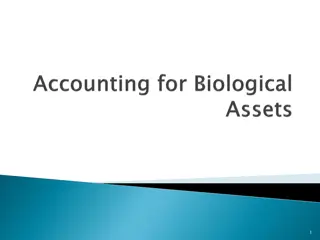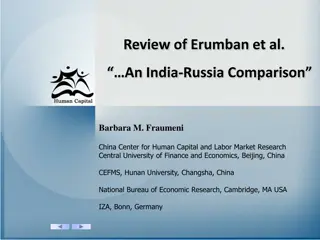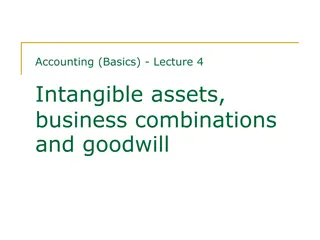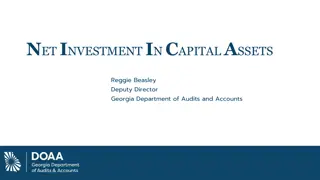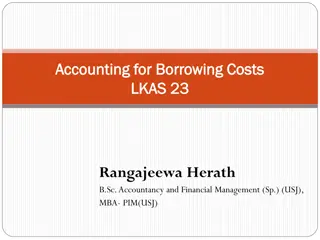Intangible Assets and Economic Growth in Russia
This study explores the impact of intermediate inputs, human capital, and intangible assets on economic growth in Russia. It discusses the productivity slowdown in Russia, changes in sources of long-run growth, and the global context influencing productivity trends in the country. The findings indicate a pattern of efficiency slowdown and the role of various factors such as capital intensity, ICT capital, and labor productivity growth.
Download Presentation

Please find below an Image/Link to download the presentation.
The content on the website is provided AS IS for your information and personal use only. It may not be sold, licensed, or shared on other websites without obtaining consent from the author.If you encounter any issues during the download, it is possible that the publisher has removed the file from their server.
You are allowed to download the files provided on this website for personal or commercial use, subject to the condition that they are used lawfully. All files are the property of their respective owners.
The content on the website is provided AS IS for your information and personal use only. It may not be sold, licensed, or shared on other websites without obtaining consent from the author.
E N D
Presentation Transcript
Intermediate Inputs, Human Capital, Intangible Assets and Economic Growth in Russia Ilya B. Voskoboynikov, Eduard F. Baranov, Vladimir A. Bessonov, Dmitry I. Piontkovski, Elena A. Staritsyna and Azamat Ulbashev The Fifth World KLEMS Conference, 4-5 June 2018, Harvard University
Productivity Slowdown in Russia and BICs (annual growth rates) a. Labor productivity b. Total Factor Productivity Source: TED database (adjusted version), May 2017
Productivity Slowdown in Russia since 1995 (annual growth rates) Source: Russia KLEMS, March 2017; Market economy
Global Context for Productivity Slowdown in Russia Catching-up (Gerschenkron 1962; Aghion et al 2006) 1950-1995: catching up to technology leaders after WW2 (e.g. Crafts and Toniolo 2010) 1995-2004: the role of ICT (e.g. Jorgenson et al 2005) 2004- present: no explicit driver of total factor productivity growth (Ark et al. 2015; Demmou et al. 2015); TFP slowdown as a statistical illusion If not (e.g. Byrne et al 2016), the rate of innovations could be the same, but technology diffusion could be lower
Do we see global origins in Productivity Slowdown in Russia (before 2014)? Change in sources of long run growth Intermediate Inputs (do not change much) Intangibles: diminishing contribution Labor composition Stable in time High in comparison with developed economies (Germany) Comparable with CEE s
Global Productivity Slowdown and Russia in the Russia KLEMS framework Recent Russia KLEMS release (2017) Russia KLEMS updates (partially progress): New official SUTs in 2011-2015 Backcast estimation of USE tables in 2003-2010 Adaptation of methodology changes of Russian SNA since 2011 This assumes taking into account Intermediate inputs Human capital Intangibles
Findings: what we see in Russia after 2008 Stagnation of 2008-2014 is more the outcome of efficiency (aggregate TFP) slowdown TFP slowdown could start before 2008, following the global economy pattern less lack of capital or intermediate inputs Partially this could be mismeasurement, but in 1995-1998 we see capital intensity slowdown lower contribution of ICT capital lower impact of labour reallocation on labour productivity growth
Labor productivity growth decomposition (p.p.) 2002-2007 Source: Russia KLEMS, March 2017
Labor productivity growth decomposition (p.p.) 2007-2014 Source: Russia KLEMS, March 2017
GO-based Labor productivity growth decomposition (p.p.), 2007-2014 Source: Russia KLEMS, updated
Sources of growth in 1995-2014 Source: Russia KLEMS, March 2017
Sectoral structure of aggregate capital intensity growth Source: Russia KLEMS, March 2017
Capital Services and the Role of Intangibles (ICT) Source: Russia KLEMS, March 2017
The role of Labor Composition Contributions (pp.) 2003- 2007 7,14 0,83 6,31 1995- 2002 2,78 -0,09 2,86 2008- 2012 1,03 -0,13 1,16 1995- 2012 3,74 0,22 3,52 Aggregate Real GDP growth Hours worked Aggr. Lab. Productivity 1,31 0,72 0,09 0,76 Labour reallocation Intra-industry Lab. Productivity Growth 1,55 5,59 1,08 2,76 1,63 -0,33 3,17 2,26 -1,61 2,47 1,16 1,38 MFP Capital Intensity 0,25 0,15 0,22 0,22 Labour composition Source: Russia KLEMS, March 2017; labor composition own calculations
Labor Composition and Labor Productivity Growth in Russia and CEEs in 1995-2007 Gr. rates (pp) RUS CZE HUN SVN GER Real VA 4,58 2,65 3,85 3,79 1,60 Hrs worked 0,32 -0,19 0,41 -0,19 -0,12 LP total 4,25 2,84 3,45 3,99 1,71 Reallocation 0,98 0,23 0,19 1,23 0,25 LP within 3,28 2,60 3,26 2,76 1,46 MFP 2,20 0,72 2,17 0,82 0,69 K/H 0,89 1,70 0,69 1,49 0,73 Lab. Quality 0,19 0,19 0,40 0,45 0,05 NOTE: Total economies. Yearly averages in 1995-2007 Russia KLEMS 2017, EU KLEMS 2008
4. Results and discussion: case of financial intermediation Gr. rates (pp) RUS CZE HUN SVN GER LP within 9,22 5,32 5,66 4,94 1,27 MFP 8,46 3,58 3,36 -1,67 0,45 K/H 0,33 1,38 1,67 6,06 0,69 Lab. Quality 0,43 0,35 0,64 0,55 0,12 NOTE: Total economies. Yearly averages in 1995-2007
Results and discussion: case of other machinery Gr. rates (pp) RUS CZE HUN SVN GER LP within 7,25 7,78 11,21 8,52 1,80 MFP 6,02 5,64 9,14 6,30 1,17 K/H 1,00 2,04 2,01 1,79 0,42 Lab. Quality 0,23 0,11 0,06 0,43 0,21 NOTE: Total economies. Yearly averages in 1995-2007
Findings: what we see in Russia after 2008 Stagnation of 2008-2014 is more the outcome of efficiency (aggregate TFP) slowdown TFP slowdown could start before 2008, following the global economy pattern less lack of capital or intermediate inputs Partially this could be the measurement issue, but in 1995-1998 my approach could catch capital intensity slowdown lower contribution of ICT capital lower impact of labour reallocation on labour productivity growth
Structural change in aggregated sectors Growth rates (%) 1995-2014 1995-2014 Contribu- tions (pp) VA share (%) 1995 2014 100,0 86,1 100,0 80,9 3,47 3,60 3,47 3,00 Total economy Market economy 7,6 4,2 1,39 0,08 Agriculture 20,1 24,2 3,59 0,80 Extended Oil and Gas sector 22,4 14,9 2,15 0,40 Manufacturing Retail, construction, telecom, hotels & restaurants (RCT) 19,2 18,6 4,07 0,77 5,1 12,0 8,41 0,72 Finance & Business Services 11,7 6,9 2,55 0,24 Transport 13,9 19,1 2,79 0,46 Nonmarket services Source: Russia KLEMS, March 2017
Sectoral structure of aggregate TFP growth Source: Russia KLEMS, March 2017
Findings: what we see in Russia after 2008 Stagnation of 2008-2014 is more the outcome of efficiency (aggregate TFP) slowdown TFP slowdown could start before 2008, following the global economy pattern less lack of capital Partially this could be the measurement issue, but in 1995-1998 my approach could catch capital intensity slowdown lower contribution of ICT capital lower impact of labour reallocation on labour productivity growth
Data: Russia KLEMS (March 2017) Nominal value added 2003-2014 official 1995-2003 official in the old industrial classification (OKONKh); official bridges btw OKONKh & NACE 1.0 for GO; VA/GO ratios for similar industries for both classifications Real value added 2003-2014 official 1995-2003 official backcast estimations of gross output (Bessonov et al 2008)
Data: Russia KLEMS (March 2017) Labour services 2005-2014 official balance of labour inputs; hours worked 1995-2005 growth rates of the yearly average number of workers from the Balance of Labour Force (BLF); breaking down with data of organizations Imputations of hours worked in non-market households in agriculture in 1995-2005 Inputs shares in value added SNA + imputations on self-employed
Data: Russia KLEMS (March 2017) Capital services Initial capital stock by types of assets Balance of Fixed Assets, net stocks by 1 January 1995 after the revaluation Breaking down by 8 types of assets with the data of SurveyF11 Bridging btw NACE 1 and OKONKh: official bridge for investments in 2003 (78 industries in OKONKh 35 industries of NACE 1) Investment deflators Production price indices in construction Installation and construction work Machinery and equipment Miscellaneous
Productivity growth trends in major market economies Source: TED database, release 06-2015 Percentage gap in GDP per worker with the United States USA AUS CAN GBR Europe5 Nordics FRA ITA LA DEU SouthEurope JPN KOR 0 -20 -40 -60 -80 1950 1972 1995 2004 2014
Productivity growth trends in CEEs and Russia GDP per worker annual growth rates (%) 5 0 -5 -10 RUS CZE POL HUN BGR ALB ROU 1950 - 1972 1972 - 1990 1990 - 1995 1995 - 2004 2004 - 2014 Source: TED database, release 06-2015 Percentage gap in GDP per worker with the United States RUS CZE POL HUN BGR ALB ROU 0 -20 -40 -60 -80 -100 1950 1972 1990 1995 2004 2014
Limitations: what we do not observe with industry growth accounting? Source: OECD 2015. The Future of Productivity
Global Productivity Growth since 1990 (annual growth rates) a. Labor productivity b. Total Factor Productivity Source: TED database (adjusted version), May 2017
Limitations Similar TFP trends in Russia and in other countries do not necesseraly say for similar determinants of these trends Consideration of the period 2008-2014 should not be automatically extended to present. E.g. the lack of capital input can be the issue in Russia now Labour reallocation between industries is minor in comparison with reallocation between firms within industries
